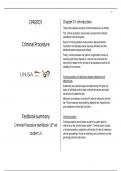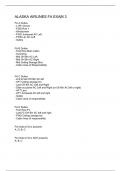1
CPR3701 Chapter 01: Introduction
Three main purposes served by criminal procedure are as follows:
First, criminal procedure must provide a process that vindicates
substantive criminal law goals.
Criminal Procedure
Second, criminal procedure must provide a dispute resolution
mechanism that allocates scarce resources efficiently and that
distributes power amongst state officials.
Finally, criminal procedure can perform a legitimation function by
resolving state citizen disputes in a manner that commands the
community's respect for the fairness of its processes as well as the
reliability of its outcomes.
Criminal procedure: the distinction between substantive and
adjectival law
Substantive law comprises legal rules determining the rights and
duties of individuals and the state; and both private law and public
law are part of substantive law.
Measures are necessary to enforce the rules of substantive criminal
law. These measures are provided by adjectival law. Adjectival law
puts substantive criminal law into action.
Textbook summary Criminal procedure
Criminal procedure also functions as part of a system which is
Criminal Procedure Handbook 13th ed referred to as the 'criminal justice system'. 'Criminal justice' consists
of criminal procedure, substantive criminal law, the law of evidence in
Joubert JJ criminal proceedings, the law of sentencing and, furthermore, the law
governing prisoners and prisons.
, 2
Roach’s two models: (2) Section 8 regulates the application of the chapter, i.e., its vertical
Roach’s punitive model of victims' rights affirms the retributive and and horizontal operation.
expressive importance of punishment and the need for the rights of (3) Sections 9-35 state the fundamental rights, ranging from the right
victims to be considered along with the rights of the accused. His to equality to the rights of arrested, detained and accused persons.
non-punitive model of victims' rights attempts to minimize the pain of (4) Section 36 is the so-called limitation clause; it regulates the scope
both victimization and punishment by stressing crime prevention and of the rights and how they may be limited.
restorative justice.
(5) Section 37 provides for derogation from the Bill of Rights following
Both punitive and non-punitive models of victims' rights promise to the declaration of a state of emergency-only to the extent that the
control crime and respect victims, but the punitive model focuses all derogation is strictly required by the state of emergency; that the
of its energy on the criminal justice system and the administration of legislation is consistent with the Republic's obligations under
punishment while the non-punitive model branches out into other international law applicable to states of emergency and that the
areas of social development and integration. derogation does not affect the rights listed and qualified in the Table
The non-punitive (as opposed to the punitive) model is less of Non-Derogable Rights following s 37(5).
concerned with the traditional criminal sanction; the non-punitive (6) Section 38 lists those who have locus standi in constitutional
model prefers to put the emphasis on prevention of crime and litigation where fundamental rights have allegedly been violated or
restorative justice, an emphasis which does not necessarily require threatened: anyone acting in their own interest; anyone acting on
strict adherence to due process. behalf of another person who cannot act in his or her own name;
anyone acting as a member of, or in the interest of, a group or class
Restorative justice involves a process that seeks to avoid the of persons; anyone acting in the public interest; and an association
invocation of the formal criminal sanctions. Its aim is to reach a non- acting in the interest of its members.
punitive resolution of a dispute stemming from criminal conduct. The (7) Section 39 contains certain important provisions relating to the
offender, the victim and members of the community are involved in interpretation of the Bill of Rights.
an attempt to restore the position which existed prior to the unlawful
conduct.
Section 35 of the Constitution – Criminal procedure section.
Constitutional criminal procedure It is important to note that criminal procedure does not deal with the
detection, investigation, and prosecution of criminals, but of suspects
Chapter 2 of the Constitution ('Bill of Rights'), is organised as follows: and accused persons. 'Suspect' generally refers to a person who has
(1) Section 7 identifies the Bill of Rights as a cornerstone of not yet been charged, ‘accused' refers to a person who has been
democracy (s 7(1)) and refers to the fact that there are limitations to charged.
the rights referred in the Bill of Rights (s 7(3)).
, 3
The Child Justice Act 75 of 2008 Chapter 2 – Criminal courts of the
The Child Justice Act 75 of 2008: in the Preamble it is stated that this
Act seeks to establish 'a criminal justice system for children in Republic
accordance with the values underpinning our Constitution and our
international obligations by creating, as a central feature of this new
criminal justice system for children. 1. Introduction
The following should be noted: The judicial authority of the Rep is vested in the courts, the courts are
independent and subject only to the Constitution and the law.
• In terms of s 1 of the Child Justice Act a 'child' means 'any person
under the age of 18 years and, in certain circumstances, means a Superior Courts: ConCourt, the SCA, the HC of SA and any court of
person who is 18 years or older but under the age of 21 years whose similar status to the HC.
matter is dealt with in terms of s 4(2)' (of the Child Justice Act). Lower Courts: regional divisions (regional courts) and district courts.
• Section 1 also defines a 'child justice court' as 'any court provided The Chief Justice of the ConCourt and the Office of the Chief Justice
for in the Criminal Procedure Act, dealing with the bail application, exercise responsibility over all courts and are responsible for
plea, trial or sentencing of a child'. establishing and monitoring norms and standards necessary for
• Where a child and an adult are charged together in the same trial in exercising the judicial functions of all courts.
respect of the same facts in terms of ss 155, 156 and 157 of the
Criminal Procedure Act, a court must apply the provisions of the 2. The Superior Courts
Child Justice Act in respect of the child, and the provisions of the
Criminal Procedure Act in respect of the adult. The ConCourt
The ConCourt consists of a Chief Justice, a Deputy Chief Justice and
9 other judges. A matter before the ConCourt must be heard by at
least 8 judges.
This court has final jurisdiction in respect of ALL matters. This court
may decide all constitutional matters and may decide any factual or
legal matters only if the ConCourt grants leave to appeal on the
grounds that the matter raises an arguable point of law of general
public importance which ought to be considered by this court. The
ConCourt makes the final decision on whether a matter is within its
jurisdiction. The ConCourt also makes the final decision on whether
an Act of Parliament, a provincial Act or the conduct of the President
is constitutional. It must confirm any order of invalidity made by the
, 4
SCA, the HC of South Africa or a court of similar status, before that ConCourt. This court has the power to develop the common law with
order has any force. due regard to the interest of justice.
The SCA has the authority to decide-
The ConCourt is the only court that may decide- (i) appeals;
(i) disputes between organs of state in the national or provincial (ii) matters relevant to appeals;
sphere concerning the constitutional status, powers or functions of (iii) any matter referred to this court in terms of an Act of Parliament.
any of those organs of state;
(ii) the constitutionality of any parliamentary or provincial Bill;
The SCA is a court of appeal only and not a court of first instance.
(iii) the constitutionality of any amendment to the Constitution; or This court does not have original sentencing jurisdiction but may
(iv) the question whether Parliament or the President has failed to correct incorrect sentences in accordance with the sentencing
fulfil a constitutional obligation. jurisdiction of the trial court as a court of first instance.
The SCA has the authority to hear an appeal against any order or
The ConCourt decides whether an applicant may bring a judgment of the HC and to decide such appeal. Persons who have
constitutional matter directly to the ConCourt. A constitutional matter been found guilty by a division of the HC may not automatically
includes any issue involving the interpretation, protection or appeal to the SCA. The general principle is that leave has first to be
enforcement of the Constitution. sought from the HC (or on refusal from the SCA) before an appeal
can be made to the SCA.
The SCA
The HC
This court has its seat in Bloemfontein but may, when it is expedient
or in the interest of justice, move its seat. The SCA ordinarily consists Each division of the HC consists of a Judge President and one or
of 5 judges for all criminal matters. The President of the SCA may more Deputy Judges President, as determined by the President,
direct that an appeal be heard before a court of three judges or, if he each with specified headquarters within the area under the
or she considers it necessary in view of the importance of the matter, jurisdiction of that division, and as many other judges for each
by a court of more than five judges. division as may be determined in accordance with the prescribed
criteria and approved by the President. A single judge presides in a
This court may decide any matter on appeal and may enquire into trial matter unless is heard by either two or three judges.
and rule on the constitutionality of any legislation or any conduct of
the President. The SCA may make an order concerning the This court has jurisdiction to decide the constitutionality of any
constitutionality of an Act of Parliament, a provincial Act or any legislation or any conduct of the President. It may develop the
conduct of the President, but such an order must be confirmed by the common law.






